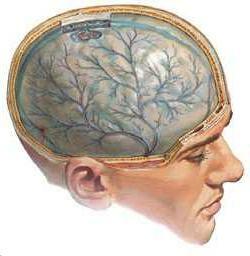 Reactive meningitis is the most dangerous form of an infectious disease affecting the parts of the spinal cord and brain.Everyone can suffer from this inflammation, however, premature newborn babies, persons with traumas of the head, back, and lesions of the nervous system are most affected.
Reactive meningitis is the most dangerous form of an infectious disease affecting the parts of the spinal cord and brain.Everyone can suffer from this inflammation, however, premature newborn babies, persons with traumas of the head, back, and lesions of the nervous system are most affected.
A feature of reactive meningitis is its spontaneity, surprise. The clinic proceeds rapidly and fleetingly. If the medical help was given too late, the patient falls into a coma and dies of multiple purulent foci in the brain. If doctors began to treat reactive meningitis within the first 24 hours, the consequences will not be so serious, but they can also threaten human life.
The rapid development of fulminant meningitis often leaves doctors time to diagnose, because even an adult a person in the absence of medical measures will not live more than 1-2 days, the children of the time are allotted even less.
Causes
Why does reactive meningitis occur, and what is it? The causative agents of this infectious disease can be various pathogens, such as staphylococcus, meningococcus, Pseudomonas aeruginosa and others.
Ways of infection are as follows:
- Hematogenous- From the inflammatory foci, the agent with blood is injected into the brain.
- Contact- trauma to the skull with infection.
- Air-droplet- when coughing and sneezing the carrier of infection, or sick person.
- Perineural- Transition of infection to brain tissue with inflammation of the nerves.
- Placental- through the placenta to the fetus from the mother.
- Lymphogenous- Transfer of infection to the brain through the lymphatic system.
According to statistics, reactive meningitis most often develops as a secondary infection, against the background of already existing meningococcal or streptococcal infections.
Symptoms of reactive meningitis
 Reactive meningitis develops lightning fast (1-2 days). The rapid growth of purulent foci and cerebral edema with belated assistance leads to the death of a person.
Reactive meningitis develops lightning fast (1-2 days). The rapid growth of purulent foci and cerebral edema with belated assistance leads to the death of a person.
The characteristic signs of reactive meningitis are expressed in the following:
- High body temperature (above 39 degrees) and severe chills. A characteristic feature of the disease is the spasmodic temperature. In the first hours of infection, the temperature reaches a mark of 40 degrees, but it is easily knocked down by antipyretic agents. However, within a few hours no medication is effective.
- Intense headache, bursting, over the entire head, amplified by movement, sudden noise or light stimulus.
- Excruciating vomiting, not associated with eating. Arises from the first hours of the disease, is extremely painful for the patient.
- Some patients may experience cramps, muscle pains, severe weakness.
- Symptoms of shock: tachycardia, arterial hypotension, cold skin with high body temperature, feet and hands of the patient acquire an ashy shade.
- Brushes and feet of the patient become gray.
- Excitation, anxiety, which appear in the first hours of the illness, are replaced by confusion, prostration and coma. There is shortness of breath, hypoxemia, oliguria, other manifestations of respiratory distress syndrome.
- Some patients have a patchy-papular rash, which after a while becomes hemorrhagic. Most often it is localized in the region of large joints, on the buttocks, on the hind limbs. However, it can appear in other places.
- DIC-syndrome develops in the absence of adequate treatment and increased manifestations of septic shock. In this case, the rash acquires a necrotic, draining character, there are collaptoid spots, gangrene develops in the fingers of the feet and brushes, hemorrhages occur in the sclera, mucous membranes of the mouth, conjunctiva, the patient's death comes from multiple organ failure and refractory septic shock.
In most patients death with reactive meningitis occurs as a result of refractory septic shock and multiple organ failure.
Diagnostics
A precise diagnosis of reactive meningitis can be made using lumbar puncture. Only in this way it can be distinguished from others, similar in clinical picture of diseases. Meanwhile, this procedure takes a lot of time, which, often, there is not an infected person.
In addition to the study of cerebrospinal fluid, common methods for diagnosing reactive meningitis are:
- examination of the fundus;
- electroencephalography;
- radiography of the skull;
- nuclear magnetic resonance and computed tomography.
In general, the diagnosis of meningitis can be made only if the patient has three main signs of the disease.
How to treat reactive meningitis
A person with meningeal symptoms should be urgently hospitalized.
In reactive meningitistreatment should be immediate and intensive, otherwise death can not be avoided. Because there is no time to determine the sensitivity of microflora, antibacterial drugs are prescribed empirically, selecting groups that can affect all possible microbes - penicillins, cephalosporins, macrolides. With increasing severity of the patient's condition, antimicrobial agents are injected directly into the spinal canal.
When spasms and muscle spasms appear, spasmolytics and muscle relaxants are used. When the function of the adrenal gland decreases, glucocorticoids are administered. To prevent cerebral edema, furosemide is administered. When the swelling has already formed, it is necessary to prescribe sorbilact. In addition, the patient will be injected intravenously with plasma substitutes, saline solutions, antipyretic agents.
Reactive meningitis is an extremely dangerous disease, the prognosis of which is unfavorable in most cases. Only timely and intensive treatment allows to avoid a lethal outcome, in children and older people progression is so rapid that often the medicine is powerless.
Preventive measures
To protect yourself from reactive meningitis, you need:
- make an appropriate vaccination;
- immediately treat any disease of inflammatory nature;
- avoid contact with the infected;
- isolate the infected;
- carefully follow the rules of personal hygiene;
- be careful when you are in a potentially dangerous area.
Effects
Reactive meningitis causes very great harm to human health. Among its consequences: deafness, septic shock, gangrene, blindness, developmental delay in children, blood coagulability, lethal outcome.
Dangerous complications can be avoided with timely treatment in a medical institution. Antibiotic therapy gives a positive result in 90% of cases of diagnosing the disease.

How to choose probiotics for the intestine: a list of drugs.

Effective and inexpensive cough syrups for children and adults.

Modern non-steroidal anti-inflammatory drugs.

Review of tablets from the increased pressure of the new generation.
 Antiviral drugs are inexpensive and effective.
Antiviral drugs are inexpensive and effective.



